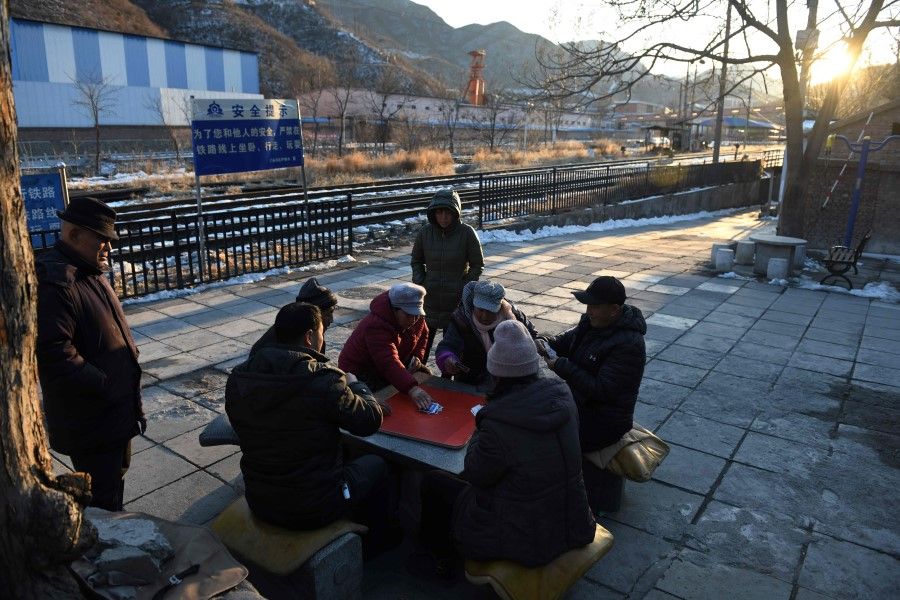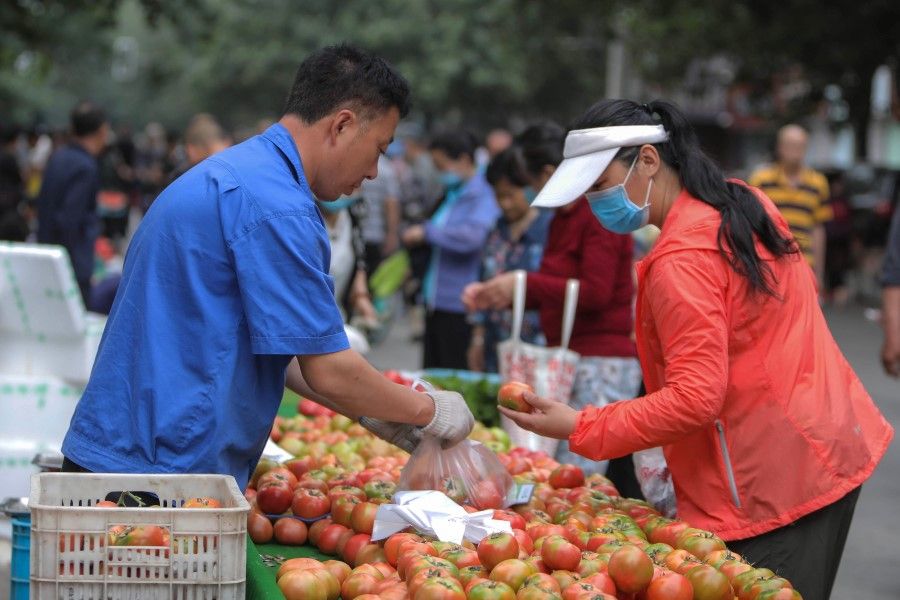Persistent poverty and a weak middle class: China's fundamental challenge

On 28 May 2020, at the press conference of China's annual "Two Sessions", Chinese Premier Li Keqiang said that China "... is a developing country with a big population. The per capita annual disposable income in China is 30,000 RMB (approximately S$5,900). But there are still some 600 million people earning a medium or low income, or even less. Their monthly income is barely 1,000 RMB. It's not even enough to rent a room in a medium Chinese city. And because of Covid-19, many families have encountered difficulties. So it is a very high priority on the government's work agenda to meet the essential needs of vulnerable groups and those families who have encountered new difficulties because of Covid-19."
The data provided has resulted in much discussion because it simply and clearly reveals the other side of China, the world's second largest economy in which the per capita GDP is US$10,000.
In 2019, the per capita disposable income of farmers in poor areas is even lower, at 11,567 RMB, averaging below 1,000 RMB a month at 966 RMB a month.
The disposable income, to which Li has referred, is the household income after deducting personal income tax, private transfer payments and various social insurance premiums, where the household includes working individuals and members of the population without an income such as the elderly and children. The data is derived from statistical and sample surveys.
Majority of China's poor in rural areas of central and western China
According to the National Bureau of Statistics of China, in 2019 the nationwide per capita disposable income is 30,733 RMB. The per capita disposable income is 42,359 RMB for urban households and 16,021 RMB for rural households. The monthly averages are 3,500 and 1,300 RMB respectively. The average monthly income of rural households is close to 1,000 RMB. In 2019, the per capita disposable income of farmers in poor areas is even lower, at 11,567 RMB, averaging below 1,000 RMB a month at 966 RMB a month.
In a 2019 survey comprising 70,000 linear stratified random samples, the research group of the China Institute for Income Distribution at the Beijing Normal University found that 39.1% of the Chinese population, or 547 million people, have a monthly income below 1,000 RMB. 52.5 million people have a monthly income of between 1,000 RMB and 1,090 RMB. Combined, a total 600 million people have a monthly income below 1,090 RMB, accounting for 42.85% of the population. This corresponds to Li's statement that 600 million people earn a monthly income below 1,000 RMB.
The survey further found that among these 600 million people, 75.6% are from rural areas, with a distribution of 36.2% and 34.8% in the central and western regions of China respectively.

The Beijing Normal University survey also shows that of these 600 million people with a monthly income below 1,090 RMB, 5.46 million have zero income, 220 million have a monthly income below 500 RMB, 420 million have a monthly income below 800 RMB, and 550 million people have a monthly income below 1,000 RMB. Taking low-medium income to be between 1,090 RMB and 2,000 RMB, 364 million people are in this category. In other words, the number of people in China with a monthly income below 2,000 RMB is 964 million.
The survey further found that among these 600 million people, 75.6% are from rural areas, with a distribution of 36.2% and 34.8% in the central and western regions of China respectively. Their average number of years of education is 9.05, which is the number of years of compulsory education. 43.7% have completed primary education or below, and 9.6% are illiterate. In this group, a very high 37.1% are not in the workforce, a high 18.0% are self-employed, and only 37.4% are salaried workers, which is significantly lower than that in other income categories.
Typically, the large majority of these 600 million people are mainly from rural areas in the central and western regions of China, with large households heavily burdened with the elderly and children. A high proportion has completed only primary education or below, or is illiterate. Most of them are self-employed, family-employed, unemployed or not in the workforce.
Many people will continue to live in relative poverty for a long time and could return to the state of absolute poverty.
The findings of China's statistics and Beijing Normal University's sample survey are consistent with common observations and knowledge. The recent revival of the "street stall economy", i.e. people setting up stalls along the street to sell their wares, illustrates a big problem. The impact of the Covid-19 outbreak on the bottom strata of society is only one of the reasons for this revival. For many, it is a practical solution to make ends meet.

The dismal state of the Chinese middle-class
Since its reform, China has lifted more than 800 million people out of poverty. However, it must be understood that the poverty in this economic miracle is in the absolute sense, and that alleviation of absolute poverty does not mean poverty has been eradicated. Many people will continue to live in relative poverty for a long time and could return to the state of absolute poverty. This also explains why the Chinese government has placed "targeted poverty alleviation" (精准扶贫) as its top policy agenda since the 18th National Congress of the Communist Party of China (NCCPC) in 2012.
...despite also achieving rapid economic growth after over four decades since its reforms and opening up, China's middle class remains below 30% of its population.
This observation about China is evident simply against the East Asian economies, without even comparing with the developed European and US economies. After more than two decades of economic development, Japan and the "four little dragons" (South Korea, Singapore, Hong Kong and Taiwan) have achieved rapid growth and created a huge middle class of 60% to 70% of their populations. In contrast, despite also achieving rapid economic growth after over four decades since its reforms and opening up, China's middle class remains below 30% of its population.
Why do so many people find this surprising? There are several reasons for this.
Today's China is a typical commercialised society in which the fittest survive and the poor are looked down upon. Although the measure of a country is determined by its scale of poverty alleviation rather than its number of wealthy people, the society remains obsessed with the rich.
In the knowledge domain, scholars are mostly capitalist economists or capitalist social scientists who are concerned with wealth creation. Even though this may be a universal issue, few economists are more obsessed with wealth creation than Chinese economists. Former Premier Wen Jiabao once lamented that China did not have economists who are concerned with the poor, which unfortunately is not profitable. Although China has lifted 800 million people out of poverty, no economist or social scientist can elucidate this phenomenon.
Many scholars sway with such "public opinion" by lavishing praises on the country's achievements and not discussing, or even obscuring, the country's problems.

Politically, the nature of nationalism has changed in recent years since China's reforms. The underdeveloped China embarked on reforms in the pursuit of prosperity by learning from developed countries. In the new millennium, nationalism in China is increasingly based on a sense of pride in a rising China, a sentiment that is particularly strong among the younger generations. Excessive spontaneous nationalism or patriotism, where one can only glorify the country's achievements and wealth but not criticise its shortcomings or poverty, will lead to undesirable outcomes. Consequently, the Gini coefficient, income disparity and social stratification become sensitive topics. Many scholars sway with such "public opinion" by lavishing praises on the country's achievements and not discussing, or even obscuring, the country's problems.
In fact, pompous flaunting of wealth has resulted in the international community's misperception of China. Western hardliners have built the "China threat" theory based upon soaring Chinese nationalism in tandem with its growth of wealth.
Persistent poverty a result of institutional problems
Long-term poverty in China can be explained by its economic development, which has several notable features as compared with the East Asian economies.
First, economic growth in China is inequitable. Japan and the four little dragons have shown equitable growth rarely achieved in the world economy, which has resulted in a relatively large middle class in their respective societies. The middle class is created through various means, such as lifetime employment and the "income-doubling plan" in Japan, a policy initiated during PM Hayato Ikeda's time to greatly spur economic growth and raise the population's standard of living; development of SMEs in Taiwan and Hong Kong; and the public housing policy in Singapore. These economies only started to show signs of greater income disparity after the 2008 Global Financial Crisis.
...the fundamentals of China's social system are inadequate in supporting the middle class and those who have emerged from poverty.
In China, while the early reforms in rural and urban areas have led to equitable growth, income disparity has increased with rapid economic development since joining the WTO. The global problem is that globalisation has created huge amounts of wealth which are in the hands of only a few people. The Western middle-class society has transformed into a wealthy society. This has similarly happened in China, albeit to a lesser extent.

Second, the fundamentals of China's social system are inadequate in supporting the middle class and those who have emerged from poverty. A social system is based upon the provision of social public goods in the three areas of medical services (public healthcare), education and public housing. In China, the system for providing these public goods is not only inadequate but also impaired by the industrialisation and commercialisation of medical services in the late 1990s, as well as the industrialisation of the education and real estate sectors after the 1998 Asian Financial Crisis and the 2008 Global Financial Crisis respectively. Together, they are the three major social problems or the "three new mountains" to scale in China. The middle-class status is safeguarded by adequate provision of these social public goods, without which there will be no assurance in the system for those who emerge from poverty.
Not all forms of growth are good for society. China must pursue equitable growth.
Third, while there is momentum for technological innovation in China, its technological ability is lacking. Scientific and technological innovations are a result of the middle class because innovation is only possible after life's basic needs are met. In addition, only the middle and upper classes can bear the risks associated with innovation. Innovation in China has largely remained in a business management model, and original and applied technological innovations are few and far between.
China must pursue equitable growth
China's reforms and opening up can be described as a painful and moving history of poverty alleviation in the pursuit of prosperity, which is the main theme of China's modern history. China ultimately chose the path of socialism because socialism was believed to be more effective than capitalism in creating wealth for the majority. To counter China's widespread perception of associating "socialism with poverty" before its reform and opening up, Deng Xiaoping proposed that "to get rich is glorious" and to create "prosperity for some in the short term so as to achieve prosperity for all in the long term". The two themes of China's subsequent reform and opening up - development and equity - had thus been established by Deng.
The transition from a planned economy to a market economy will inevitably result in the widening of the rich-poor gap. In the first decade of the new millennium, China's economy has grown rapidly due to its market reforms and accession to the WTO. However, social stratification has also emerged with consequences. Turning to social development, the 16th NCCPC in 2002 proposed the concepts of "harmonious society" and "scientific outlook on development". Although economic growth should not be doubted, the nature of growth is more important because not all forms of growth are good for society. China must pursue equitable growth.

Since the 18th NCCPC in 2012, the Chinese government's top agenda item is social equity. For many years, it has mobilised and invested considerably in targeted poverty alleviation, lifting 10 million people out of poverty annually.
The Chinese leadership is highly conscious of the developments within China, and the past and present leaders have been guided by two basic beliefs. Domestically, China will remain in the "primary stage of socialism" and externally as a "developing country", both for a long period of time.
Unless African Americans change their social strata or their class position, racial tensions will continue... China must heed this warning.
Today, the dire situation confronting the bottom strata of society everywhere in the world cannot be underestimated. Among all levels of society affected by the Covid-19 pandemic, the bottom strata suffer the most. The nationwide racial violence in the US, while ostensibly a race issue, essentially concerns the issue of social strata or class. Unless African Americans change their social strata or their class position, racial tensions will continue.
China must heed this warning. As discussed above, the bottom strata of the Chinese society remain huge and the fragile society is unable to withstand crises. Meanwhile, China's relatively small middle class continues to suffer in an inadequate social system.
China's reforms need to solve the problems of development and equity
To further advance the country's latest reforms, the 19th NCCPC consolidated the ruling party's leadership through institutional reforms in 2017. This was given a boost through two documents issued by the CPC Central Committee and the State Council this year.*
...reforms must not stop even after 60% to 70% of the population attain middle-class status.
Legally, the National People's Congress has on 28 May 2020 adopted the long-awaited PRC Civil Code, the most important legal achievement after the Fourth Plenary Session of the 18th CPC Central Committee proposed to advance the rule of law in China in 2014.
In addition, following the earlier series of open policies, the recent two sessions have adopted the masterplan for the Hainan Free Trade Port, and launched the commencement of work on the relevant laws for the free trade port. These constitute a further significant step in the opening up policy to ensure that it is safeguarded by law, so that the country's openness is not swayed by political will.

Both the Western and Asian economies have shown that a robust economic basis for social stability can only be achieved after 60% to 70% of the population have attained middle-class status. As an ancient Chinese saying goes, one shall have his peace of mind when he possesses a piece of land. However, reforms must not stop even after 60% to 70% of the population attain middle-class status. The rise of populism in the US and the West today is caused by the persistently shrinking middle class.
...since the problem of making a bigger pie has not been solved, the problem of distributing the pie likewise remains unsolved.
A country's external strength is dependent on a strong domestic middle class. The strength of all developed countries lies in the size of their middle class because the middle class forms the core of the society's consumption.
If Deng Xiaoping was alive, he would certainly remark modestly that China has not solved the two main problems of development and equity. In other words, since the problem of making a bigger pie has not been solved, the problem of distributing the pie likewise remains unsolved.
Although reforms have started again, the Chinese society remains far from being a prosperous and equitable one. China cannot afford to slacken or be arrogant. This is so that it stays focused on its endeavours to alleviate poverty, a problem that plagues the majority of the population.
* On 11 May 2020, the CPC Central Committee and the State Council issued "Opinions on Accelerating the Improvement of the Socialist Market Economy in the New Era", which followed the 19 April 2020 issuance of "Opinions on Building Improved Systems and Mechanisms for Market Allocation of Factors". These documents signal the deepening of market reforms, and follow up on the "Decision on Some Major Issues Concerning Comprehensively Deepening the Reform", formulated by the Third Plenary Session of the 18th CPC Central Committee in 2013.
